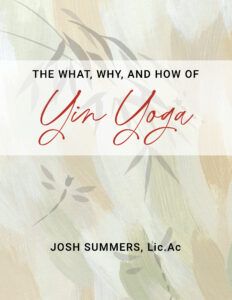Earlier in this series, we looked at aesthetic alignment vs. functional alignment. In short, aesthetic alignment tries to establish whether a pose is correct and safe by the way it looks: Are the thighs parallel? Are the hands shoulder-width apart? In contrast, functional alignment considers where and how a practitioner intends to stress (exercise) the target areas in the body, and then evaluates whether that intention is served when entering the pose – and while in the pose itself. You can explore that here with Dragon Pose. Practitioners are encouraged to test modifications to see which best achieves their intention, keeping in mind that modifications are different for everyone based on their unique anatomy.
Now, the second important facet of functional alignment is not stressing an area of the body you don’t intend to stress. Whenever you are in a Yin Yoga pose, you want movement to originate from the joints that are proximal to the axial skeleton – in other words, closest to the body’s core. So when you move your legs, you initiate from the hip socket, not the knee. Or when you move your arms, you initiate from the shoulder girdle, not the elbow. When movement is restricted at proximal joints, distal joints (joints further from the core), like the knee, try to compensate. As Yin Yoga pioneer Paul Grilley says, “you don’t want to punish the distal joints for what the proximal joints can’t do.” A good way to understand this is through Swan Pose, the Yin version of Eka Pada Rajakapotasana (yang yoga’s Pigeon Pose).
Preventing Injury: Swan Pose
Potential Target Areas: External rotators of the front leg’s outer hip; front leg’s adductors and inner hamstrings; back leg’s hip flexors
Not Targeting (Don’t Intend to Stress): Front knee
The Anatomy of Swan Pose
In Swan Pose, the front thigh and femur are moving with a combination of flexion, abduction, and external rotation. When this happens and the knee is flexed, the collateral ligaments of the knee loosen, allowing for more movement at the knee joint. But if the hip is restricted, the knee will try to compensate for what the hip can’t do – potentially leading to injury. The increased mobility can send signals of distress (i.e. pain) to your knee’s medial meniscus if the stress is too significant.
When the knee is flexed and the thigh externally rotates, many factors will contribute to when and where the knee experiences stress, including:
- Soft-tissue tension in any of the hip’s muscle groups can restrict the thigh’s degree of external rotation, shifting movement downstream to the knee.
- Skeletal variations influence the hip’s range of motion; the hip socket (acetabulum) plays a major role, and the hip socket’s orientation, angle, and depth will determine when and where the knee comes to a point of stress.
- The length and size of the femur’s neck, the angle of the femoral neck shaft, and the amount of twist in the femur (femoral torsion) determine the range of femoral external rotation that can be achieved before deleterious stress is placed on the knee.
Let’s now dive into how different styles of alignment can help you eliminate stress on the knee.
[Refer to the two images of me in the pose – but keep in mind that your alignment may not look like mine because each of our our bodies have unique shapes.]
Aesthetic Alignment in Swan
In this version, my right knee is lined up behind my right wrist, my right heel is just forward of my left hip, my hips are level. By many standards, I’m in the “correct” alignment. But functionally, I’m courting disaster. My right knee hurts. That’s because in this particular alignment, I can’t generate enough external rotation of my thigh, and my knee is trying to compensate, painfully squeezing my medial meniscus.

What may look “correct” and safe is functionally bad and unhealthy. To remedy my knee pain, a well-intentioned teacher my prop my right hip. And it’s true that, by supporting my hip, this may allow the thigh to externally rotate less (relieving my knee), but this may not work. It also may remove all advantageous stress that I was seeking for my hip.
Functional Alignment in Swan
Now look at my collapsed Swan: I let my right hip come all the way to the ground, tilting both my hips. In this position, my right thigh and femur aren’t being asked to externally rotate as much as in the aesthetic version. My knee is no longer stressed, but I’m still experiencing the desired stress in my outer right hip. Ugly as collapsed Swan may be, it is functionally best for my body.

Remember, what’s functionally optimal for my body might not be for yours. This is why in Yin Yoga we give students so much freedom to explore variations. And in learning how and why your body experiences limitation in Yin Yoga, you’ll be able to apply that firsthand knowledge to your other yoga practices.
—
Another important aspect of avoiding injury Yin Yoga is what I call, “playing one’s edge.” There are two components to this concept, which I’ll get into in the next lesson.
Practice Opportunities:

